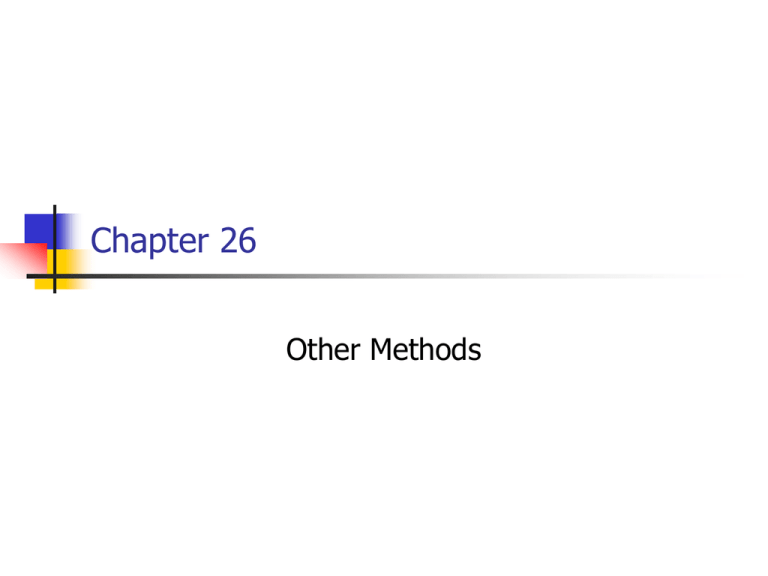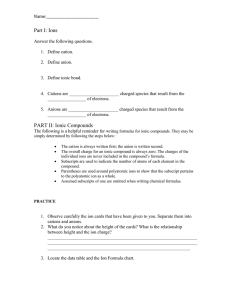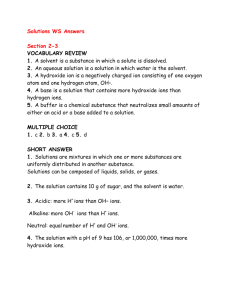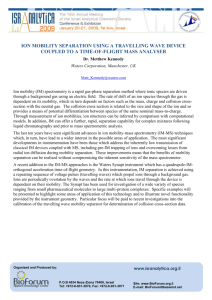Chapter 26
advertisement

Chapter 26 Other Methods Ion-Exchange Chromatography The mechanism of separation will be the exchange of ions from the column to the solution. Water softening – exchange Na ions for Ca and Mg. Water deionization – exchange H ions for cations and OH ions for anions. Leaving water. Can be larger scale. The support is modified to allow for the ion exchange equilibrium. Can be natural materials or synthetic Polymerization These aromatic rings can be modified Or to make an anion exchanger Gels vs Resins Resins are firm and can stand greater pressure. Gels are softer – have lower charge densities and are made from polymeric sugars. Polyacrylamide can also be used a the backbone. Sephadex Ion Exchange Selectivity Equilibrium system R-Na+ + Li+ = R-Li+ + Na K = [R-Li+][Na+]/[R-Na+][Li+] K is called the selectivity coefficient Which ions have greater affinity Higher charge, higher polarizability and decreased hydrated radius. Pu4+>>La3+>Ce3+>Pr3+>Eu3+>Y3+>Sc3+>Al3+ >> Ba2+> Pb2+ > Sr2+ > Ca2+ > Ni2+ > Cd2+ > Cu2+ > Co2+ >Zn2+ > Mg2+ > UO2+ >> Ti+> Ag+> Rb+> K+ >NH4+> Na+> H+> Li+ Reconditioning by having higher concentration of the less tightly held ion. Donnan Equilibrium Concentration of ions outside the resin will be higher than the inside concentration. Cations will be excluded from the inside of an anion exchanger. (Has same charge as resin site) Ion Exclusion Chromatography Non charged species can migrate in but not ions. Ion Exchange Types Resins Gels Inorganic exchangers (Zeolites) Use a gradient to remove stronger bound ions. Separation of Lanthanides Applications Preconcentration Water deionization. Pass much water over a resin and then elute with a high concentration of acid. Cation exchange to trap cations Chelex -100 to trap transition metals. Cation exchange from cation removal. Anion exchange for anion removal. Water softening Ion Chromatography HPLC ion exchange. Detection is an issue. Ions do not absorb uv/vis light. Conduction is used to detect ions but the mobile phase will have high electrolyte like KOH We use ion suppression Examples Unsuppressed Ion Chromatography The ions have higher conductivity than the eluent. Carboxylic acids used as eluent. Indirect Detection. Mobile phase has a light absorbing ion. Phthalate ion. Ion Pair Chromatography Separate ions on a reverse phase column. (Ammonium ions) Add a surfactant to the mobile phase. Such as sodium octane sulfonate. Molecular Exclusion Chromatography Separation Based on Size Only Gel Filtration Gel Permeation Large molecules can not get into the internal diameter so the elute more quickly. Vt = Vo + Vi + Vg + Vec Vt is the total volume of the system. If we ignore volume outside the column then we have Vt’ = Vo + Vi + Vg Vo is the elution volume for large molecules Vo + Vi is the elution volume for small molecules Elution Ve = Vo + KVi Kave assumes that Vg is very small and I suggest you not use it. K will fall between 0 and 1 unless there is another mechanism in the column. Stationary Phase A solid support with internal volume of fixed size. There are many options available. Both low pressure and high pressure (HPLC) Determination of Molecular Weight Plot Log (MW) vs elution volume Affinity Chromatography Stationary phase is made so that it has a very specific interaction that can cause binding to a specific substrate. Elution is carried out by disrupting this interaction. (Change pH is an example) Antibody IgG1 using Protein A Capillary Electrophoresis Motive force is no longer pressure but electrical migration. Cations migrate to the cathode Anions migrate to the anode High electric field place across a capillary column. CZE Very high resolution due to the lack of no packing or stationary phase, no A term or c term in the van Deempter equation. H = A + B/ux + Cux Just longitudinal diffusion plays a role. Single Cell Analysis Benzyl Alcohol Separation Mobility Ion of charge q will accelerate in the potential field until the frictional force counter balances it and it travels at constant speed. uep = q/f*E = mepE mep is electrophoretic mobility Relates speed and charge Directly related to charge, indirectly related to size Stokes Equation F = 6phr h is the measure of solution viscosity This allows ions to move, what about neutrals. Electroosmosis Bulk Solution now flows toward the cathode. Electroosmotic Flow (EOF) ueo = meoE Units of the electroosmotic mobility is m2/[V.s] Joule Heating Capillary tubes must be narrow enough to get rid of the excess heat. 50 mm tubes are ok but 1 mm would be a real problem. Some are cooled. Heat is related to I2R Apparent Mobility Two mechanisms for movement. Electrophoresis and Electroosmosis. Can be going the same direction or the opposite. mapp = mep + meo Apparent Mobility Speed divided by electric field. m app Ld u net t V E Lt Ld is the length to the detector and Lt is the total length. Electroosmotic Mobility uneutral Ld tneutral meo V E Lt Separation is based on size and charge • Bovine carbonic anhydrase – acetylated at the lysine residues R-NH2 Plates and Resolution N = Ld/s2 Or N = mappV/2D* Ld/Lt Resolution Same as for GC or HPLC Resolution Improvement (Increase E) Injection Two Modes Hydrodynamic Injection Electrokinetic Injection Detection UV is most common. UV Detection Electrochemical is also used Electrochemical Detection Example Indirect Detection of Ions Elution order In CZE Cations – highest mobility first Neutrals – unresolved Anions – highest mobility last MEKC – Micellar Electrokinetic Chromatography Add a surfactant to the mobile phase. Micelles form above the CMC Neutral species will partition into the micelles and flow at that rate





